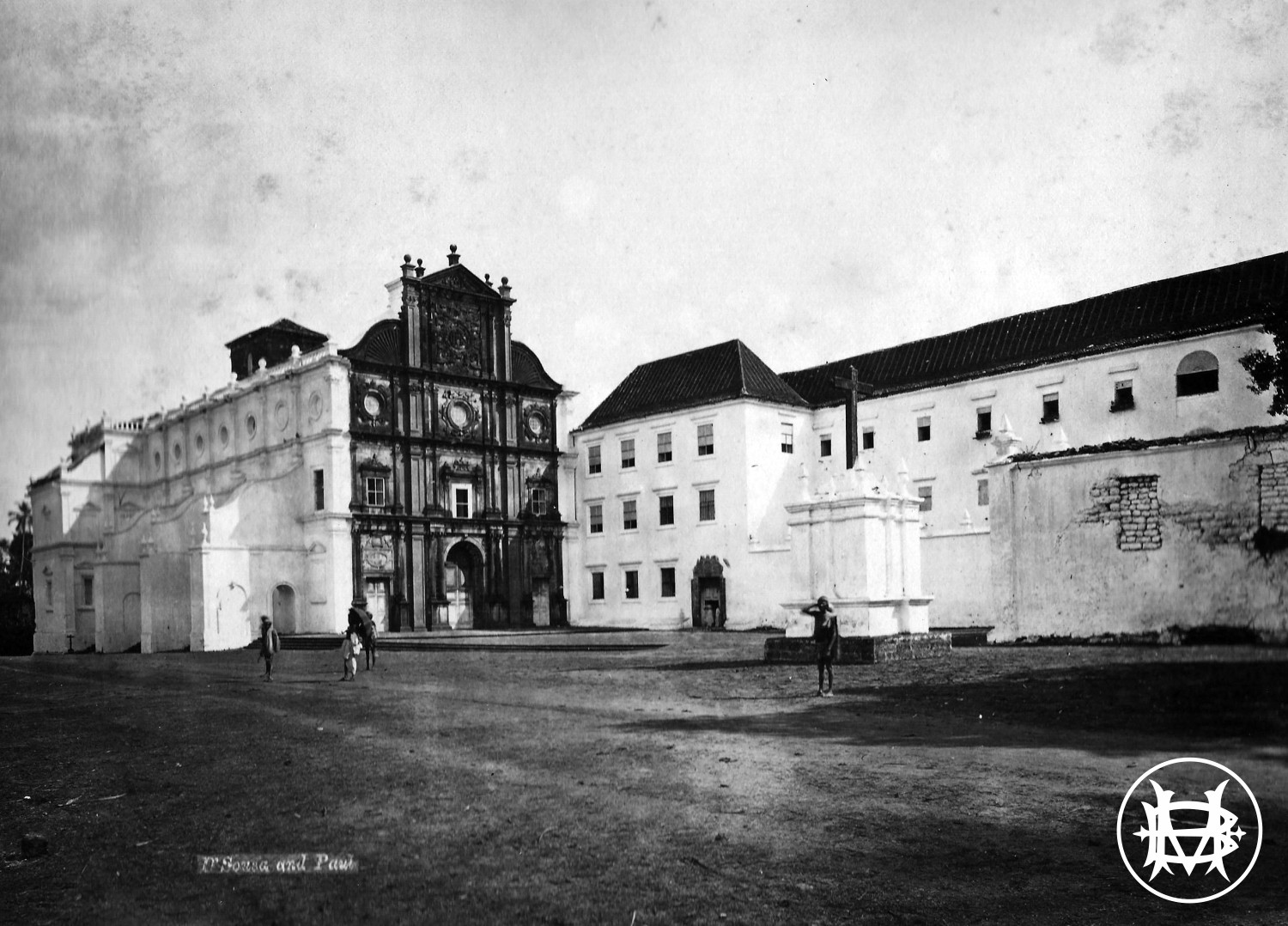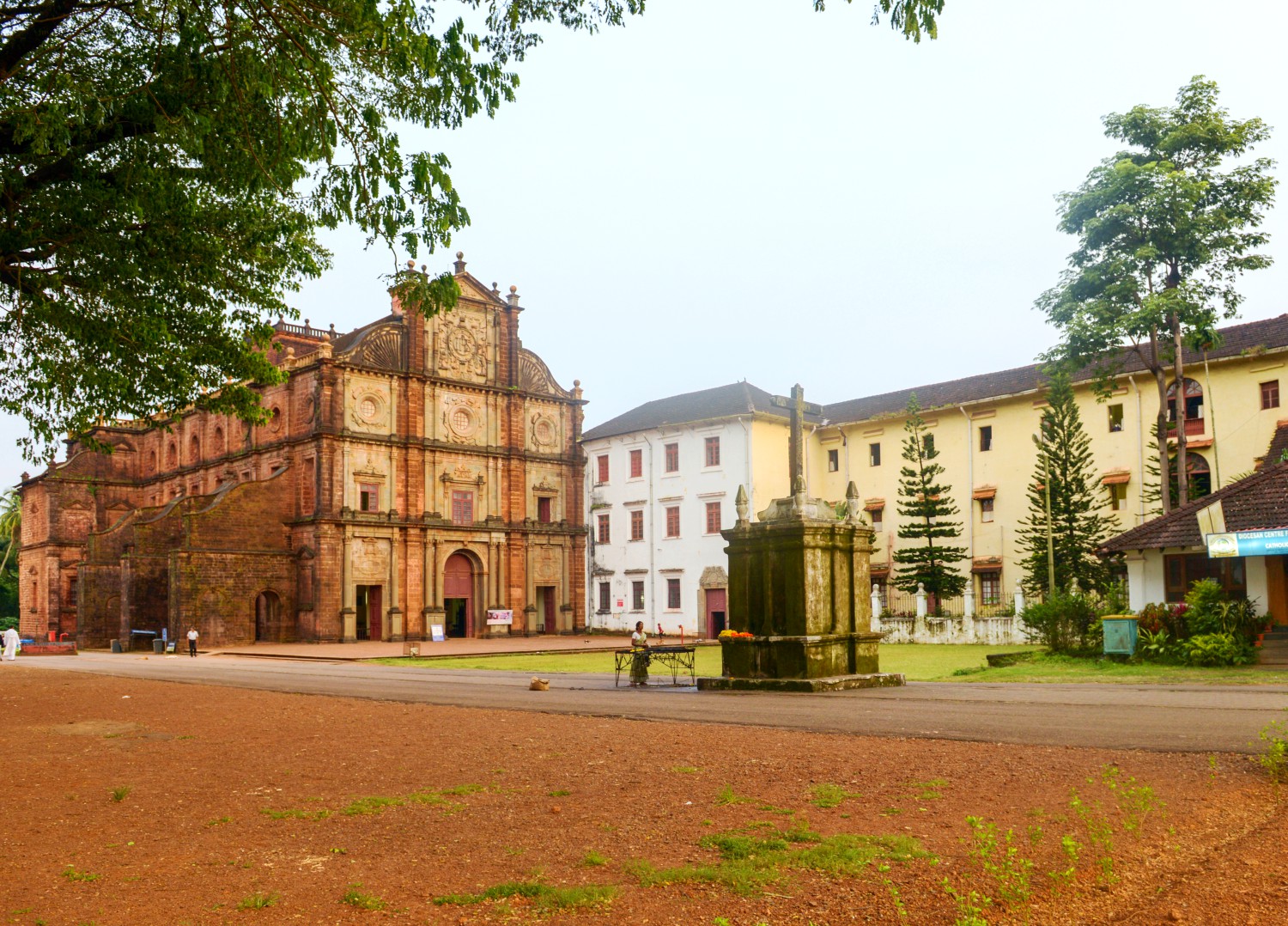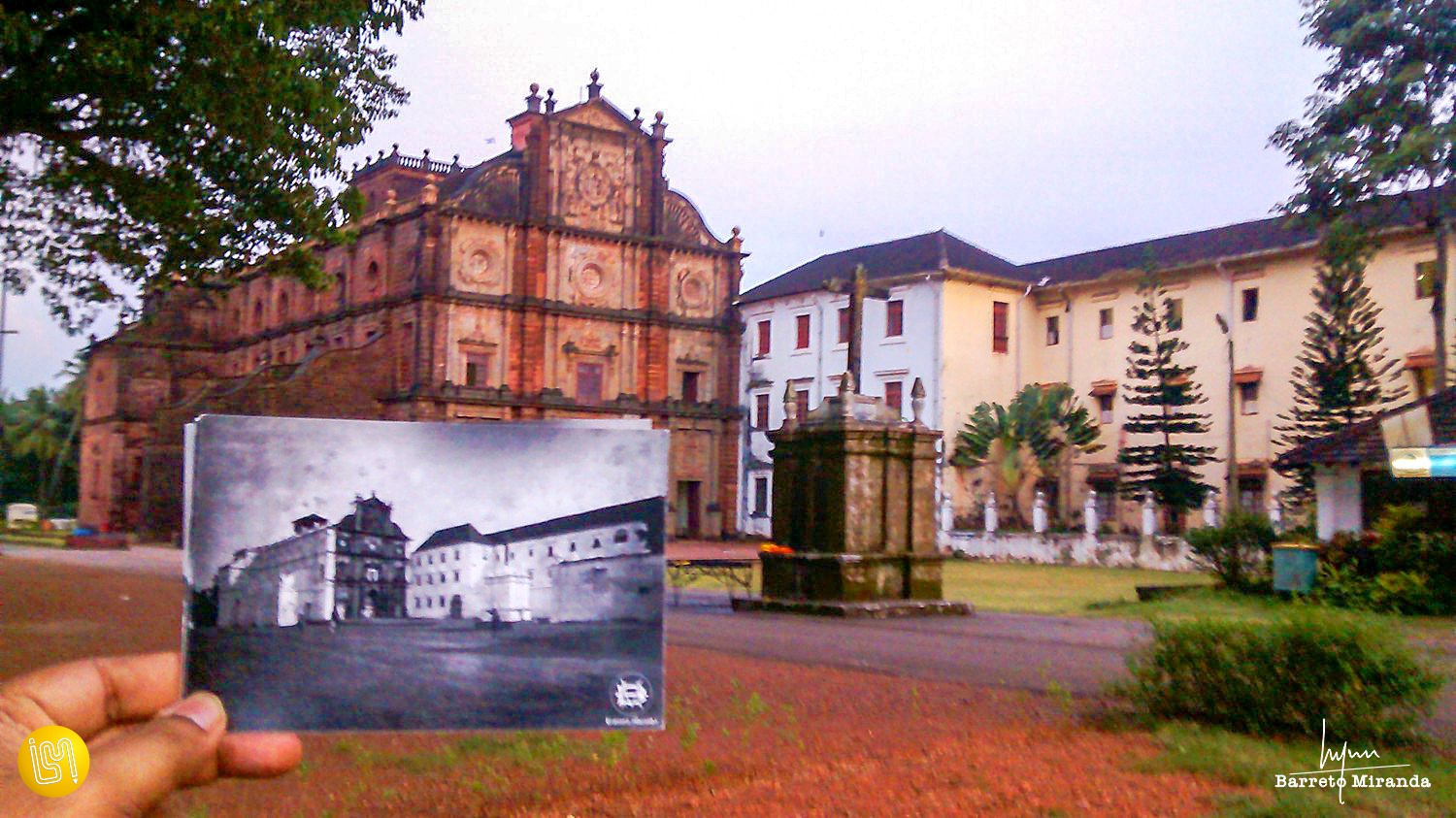

The Bom Jesus Basilica is a World Heritage Monument.. Its un-plastered exterior appears at first glance to be inferior as compared to the sparkling facades of churches like the Se Cathedral, but this little Basilica is rich in art, architecture and history, and the relics of Saint Francis Xavier are enshrined here.
Claim to fame
Houses the relics of St. Francis Xavier and is the only Basilica in Goa.
History, Construction and Architecture
The Basilica of Bom Jesus is a monument typical of the classic forms of plane architecture, introduced by the Society of Jesus, otherwise known as the Jesuits. The façade, which is of granite, represents features of five styles of architecture: Roman, Ionic, Doric, Corinthian and Composite. It is a large single Nave structure built ( 1595-1605) and paid for with legacies left by Dom Jeronimo Mascarenhas, a wealthy Portuguese Captain of Cochin.
It is the only monument with a façade not covered with plaster. The plaster was stripped off in 1950’s by an over-zealous Portuguese conservationist who believed that this would help preserve the carvings on the façade better. Unfortunately, even though this was soon seen to be a false assumption, no one has put the plaster back.
The foundation stone for this church was laid on the 24th of November, 1594. Archbishop Rev. Fr. Aleixo de Menezes consecrated the church, on its completion on the 15th of May 1605. However, it was only raised to the status of “minor Basilica” in 1946.
The three-storied structure stands 75ft wide and 78½ft tall. The façade of the church, though un-plastered, is a magnificent example of baroque architecture. It combines elements of Doric, Ionic and Corinthian design, and is divided into four parts.
The lowest section has three doors set into it, a large one in the middle with two smaller ones flanking it. The second section has three square windows whose positioning corresponds to that of the doors. The third section has three circular windows whilst the last section forms a quadrangle, lavishly decorated with arabesque. This quadrangular pediment also has “IHS” carved into it. This is the Jesuit emblem and stands for “Iesus Hominum Salvator”, which is Latin for, “Jesus, Saviour of Men”. All the sections have carved basalt pillars. The basalt was mined from Bassein in the North of Goa.
Interior and Artwork
The interior of the church is a study in contrasts. The design in itself is simple, but the floor is laid with the finest marble, and was inlaid with precious stones. The altar is elaborately carved and gilded.
The retable of the main altar exhibits a huge statue of Saint Ignatius of Loyola, the founder (along with St. Francis Xavier who was a founding member) of the Society of Jesus and below it, a small image of Bom Jesus (Child Jesus), the patron of the church.
On the southern side of the transept lies the Chapel of St. Francis Xavier. This chapel has carved and gilded columns and wood-carved floral decorations. This is where the relics of the saint are kept. There is a gorgeous silver statue placed in front of the silver casket where the body of St. Francis Xavier reposes.
The interior of the Basilica measures 83ft in length, 51ft in width and 61ft in height. It is laid out in the orthodox cruciform fashion with a single nave and transept. The ceiling was once vaulted, but has since been replaced with a simple wooden one. The main altar measures a massive 54ft by 30ft. The interiors, while being furnished with the best of materials show a remarkable simplicity typical of Renaissance design.
The Basilica contains two chapels, three altars, a sacristy and a choir loft. There is also a belfry at the back. The door through which one enters stands beneath the choir loft. To the right is an altar which is dedicated to St. Anthony and to the left is a well-carved statue of St. Francis Xavier. On the northern wall of the nave is the cenotaph of Dom Jeronimo Mascarenhas. He was the Captain of Cochin and his estate made possible the construction of the Basilica.
The columns which support the choir loft bear plaques inscribed in Portuguese and Latin detailing the dates of the Basilica’s construction and consecration. In the transept are two altars which flank the main one. They are highly carved and decorated and are dedicated to St. Michael and Our Lady of Good Hope.
The main altar is extremely well carved and gilded. It is backed by an ornate reredos which stretches from floor to ceiling, its baroque carvings in sharp contrast to the classically plain design of the Basilica. The reredos has within it a large statue of St. Ignatius of Loyola protecting the Infant Jesus. His eyes are raised to a carved disc, once more bearing the Jesuit emblem of “IHS”. Above this medallion is a depiction of the Holy Trinity, i.e. The Father, The Son and The Holy Spirit.
On the northern side of the transept is the Chapel of the Blessed Sacrament. On the southern side is the Chapel of St. Francis Xavier. Adjoining this chapel is a corridor leading to the sacristy, accessed by a marvellously carved wooden door. It is a vaulted wooden structure ending in an apse. In this reposes an altar which has an iron chest containing the Golden Rose which was bestowed upon the Se Cathedral by Pope Pius XII.
The walls are hung with paintings of the saints and the sacristy also contains a beautifully carved chest of drawers. Near the iron chest is a painting of the relics of St. Francis Xavier, done about 100 years ago.
Modern Art Gallery
The Basilica also contains a modern art gallery with paintings depicting various Biblical scenes. The gallery can be accessed using the stairs near the sacristy. It is one of the largest of its kind in Asia. It contains 36 paintings executed between the years 1973 and 1976. The artist was paid only for the materials used as his talent was given gratis, for the greater glory of God.
The most notable paintings are entitled “The Last Judgement” and “Genesis”
Tomb of St. Francis Xavier
Fr. Francis Xavier died of a fever in 1552 on the island of Shangchaun, whilst waiting for a boat to travel to China. His last rites were performed and he was laid to rest in a simple coffin in the Portuguese colony of Malacca. When his remains were disinterred some years later, they were found to be “fresh and intact”. Upon hearing of this, the Vatican canonized him a saint. His remains were buried in three different places before they came to their final resting place in Goa.
The arrangements of keeping the body of St Francis Xavier in the Chapel were completed on 24th April 1659. The mausoleum, in Florentine style, was the offer of the last of the Medici’s, Cosimo III, Duke of Tuscany. It is a masterpiece setting and was made by Giovanni Batista Foggini and assembled in Goa by Placido Francesco Ramponi.
The silver casket is made up of silver panels which depict 32 scenes from the life of the saint. These panels were created for this purpose by Goan silversmiths under the supervision of Fr. Marco Mastrilli SJ.
The tomb of the great saint, rests beneath a shower of gilt stars. It has three parts: the altars, the Florentine mausoleum and the silver casket. There are four altars, one on each of the four sides of the tomb. They are constructed of reddish jasper with white strips which are ornamented with flourishes and fringes. There are two Cherubim in each corner. They are made of pure alabaster. In the centre of each altar’s frontispiece there is an emblem in bold relief. Above the altars is a quadrangle of spotted jasper. On all four sides are bronze plaques depicting scenes from the life of the saint.
In the first scene we see St. Francis preaching to the Malaccan people. Above the panel is a bronze sun disc and two alabaster angels holding a bronze banner inscribed with the words “Nox inimical fugat”. The second scene shows St. Francis baptisting the Malaccans with his right hand and holding a crucifix in his left. The bronze sun is at it’s zenith above this plaque and the banner held by the angels reads “Ut vitam habeant”. The third scene depicts St Francis being attacked by the Moro islanders with stones and arrows. The bronze medallion shows a lion in a storm and the banner reads “Nihil horum vereor”. The fourth plaque shows the death of St. Francis on the island of Shangchaun surrounded by his disciples. The medallion depicts the setting sun and the banner reads “Major in occasu”. Taken together these four Latin phrases can be roughly translated to mean “I drive away the enemy of the night, that they may have new life and fear not the great setting of the sun”
Above this quadrangle is a balustrade of jasper and it is on this balustrade that the silver coffin rests. There are 32 silver plates which form the four sides of the casket. The scenes that they depict are as follows:
- Francis lies on the ground with his arms and legs tied, but the cords are miraculously broken.
- Francis kisses the ulcer of a patient lying in a Venetian hospital.
- He is visited by St. Jerome as he lies ailing in the hospital of Vicenza.
- A vision about his future apostolate.
- A vision about his sister’s prophecy regarding his fate.
- He saves the secretary of the Portuguese Ambassador while crossing the Alps.
- He lifts a sick man who dies after receiving communion.
- He baptizes the people in Travancore.
- He resuscitates a boy who drowned in a well at Cape Comorin.
- He miraculously cures a man full of sores.
- He drives away the Badagas in Travancore.
- He resuscitates three persons: a man who was buried at Coulao; a boy about to be buried at Multao and another child.
- He takes money from his empty pockets and gives to a Portuguese beggar at Malyapore.
- He effects a miraculous cure.
- A crab restores his crucifix which had fallen into the sea.
- He preaches in the island of Moro.
- He preaches in the sea of Malacca and announces victory against the enemies.
- He converts a Portuguese soldier.
- He helps the dying Vicar of Malacca.
- Francis kneels down and on his shoulders there rests a child whom he restores to health.
- He goes walking from Amanguchi to Meaco.
- He cures a dumb paralytic in Amanguchi.
- He cures a deaf Japanese person.
- He prays on the ship during a storm.
- He baptizes three kings in Cochin.
- He cures a religious person in the College of St. Paul.
- Due to lack of water, he sweetens the sea water, during a voyage.
- The agony of Francis at Sancian.
- After his death he is seen by a lady according to his promise.
- The body dressed in sacerdotal vestments is exposed for public veneration.
- Francis levitates as he distributes communion in the College of St. Paul.
- The body is placed in a niche at Chaul with lighted candles.
The casket is topped by a cross standing on a pedestal with the figures of angels, one on either side. The angel placed near where his head rests bears a heart with a halo, whilst the one near his feet has the motto “Satis est! Domine, satis est” which means “It is enough, Oh Lord, it is enough”
During the time of the exposition, the plates on the side of the silver casket are removed so that devotees may see the “intact” remains of the saint through the glass urn. The glass urn was put in place after the exposition in 1954, when it was decided that the relics should no longer be directly touched. It was made in the Casa Brandizzi in Rome and the relics were placed inside with all ceremony in 1955, before the whole was placed into the silver casket.
Professed House
The construction of the Professed house, which lies next door to the Basilica, began in 1585 and so predates the Basilica by a few years. It is a two-storied building, built of laterite rock and covered with lime plaster. Its construction was completed in 1589 under the aegis of Br. Domingos Fernandes.
This became the mission centre for all Jesuit missions to the eastern regions of the known world. The “Casa Professa”, according to Jesuit canon, was intended for the exercise of the Ministries of the Society of Jesus, and should be conspicuous for its exact adherence to the Jesuit way of life.
Legend and Lore
The legend has it that the Jesuits who wanted to construct the Professed House and later the Basilica met with stiff opposition from the Portuguese administration. They had a house on the property, but were being denied permission to build the church. On the eve of the day when they were to be evicted, the wily priests converted the house into a make-shift church, painting the word “Jesus” on the door and putting up a bell. The next morning the bell was rung, much to the surprise of the inhabitants of the surrounding areas, to call them for Mass. After that, the Portuguese were never able to evict the Jesuits from this place.
Another interesting tale from the history of this Basilica is that the Duke of Tuscany, who sponsored the building of the mausoleum of St. Francis Xavier, did so out of gratitude. He had been presented with the pillow upon which the saint’s head had been resting by the Jesuit Procurator General of Goa. He felt that such a great saint deserved a grander resting place.
Many stories have originated around the relics of St. Francis Xavier. Some believers claim that his body shrinks every year, and when it shrinks to nothing, it will signify the end of the world. Others tell a tale of a woman, who whilst bending to kiss his feet in devotion bit off his big toe. They say that though the toe was bitten off a corpse it yet bled and so she was caught out and the toe returned to the rest of the relics.
Simple yet regal, austere yet opulent, unassuming yet grand, this Basilica has risen from its humble beginnings into a world famous monument that commands respect and worship from religious pilgrims and architectural buffs alike. The atmosphere of the Basilica is cool, calm and majestic. The awe-inspiring feeling of being in the presence of something much greater than oneself is a truly humbling experience.
Info: https://goa-tourism.com/jesus

